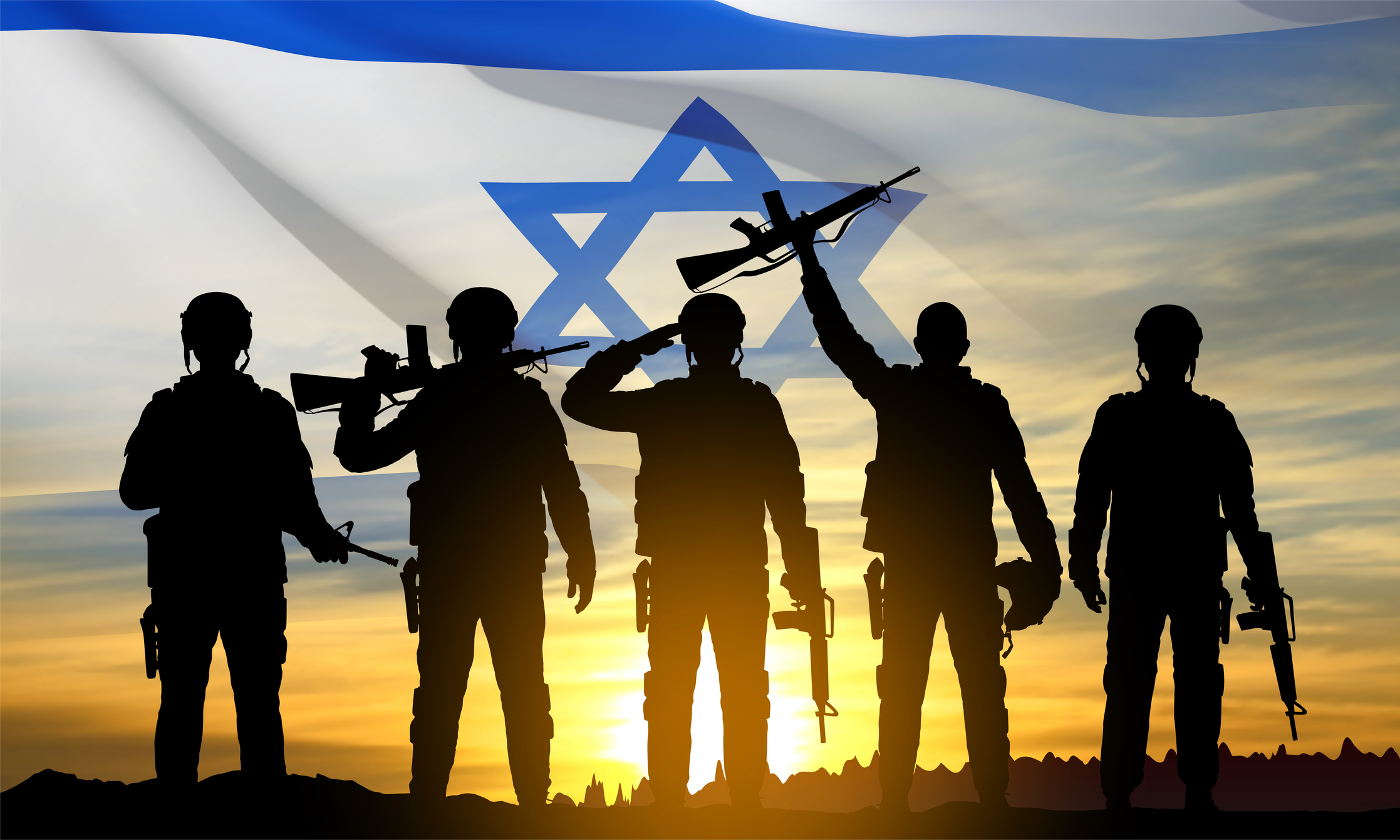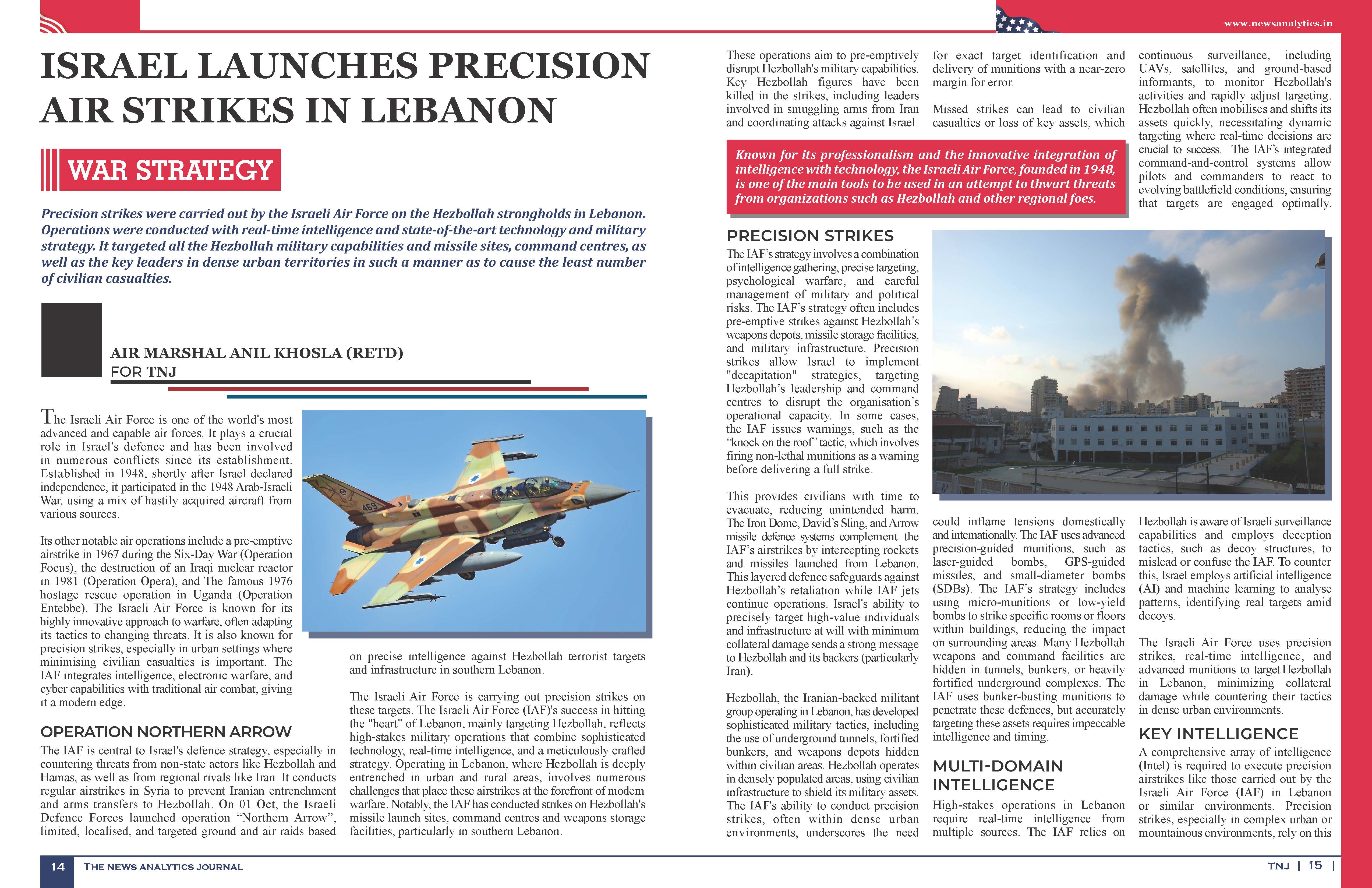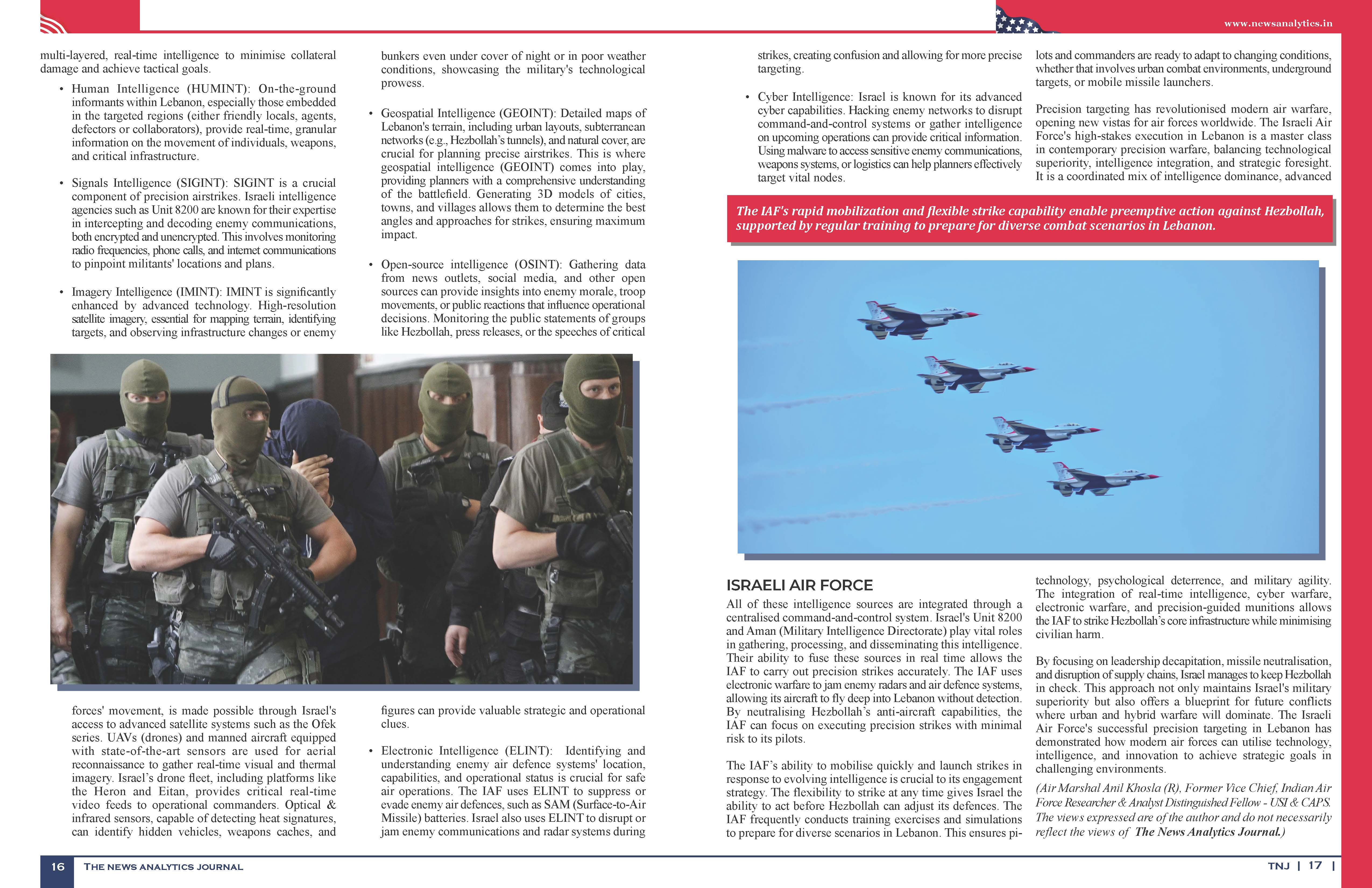
Pic: Courtesy Internet
My article published on the Chanakya Forum website on 05 Nov 24.
The Israel Defence Forces (IDF), also known in Hebrew as Tzahal, are the military forces of the State of Israel. Tzahal, which stands for Tzva HaHagana LeYisrael, is the Hebrew acronym for the Israel Defence Forces (IDF). It translates literally to the “Army of Defence for Israel. Tzahal is deeply integrated into Israeli society due to mandatory military service and is prominent in the national consciousness. Established in 1948 following the creation of the state, the IDF serves as Israel’s primary defence organisation, protecting the country’s sovereignty and citizens.
The IDF has been involved in various conflicts and military operations, including wars with neighbouring states (1948, 1956, 1967 Six-day War, 1973 Yom Kippur War) and numerous operations in Gaza and the West Bank, particularly in the context of the Israeli-Palestinian conflict. The ongoing tension and violence between Israel and groups like Hamas and Hezbollah, as well as border defence, are central focuses of the IDF’s modern-day operations. It uses a combination of ground, air, and naval forces for these operations. Numerous lessons can be drawn from this active and experienced force.
Israeli Defence Forces
Tasks and Roles. IDF’s primary mission is to protect Israel’s borders and ensure the security of its citizens. This involves deterring potential threats, carrying out defensive and pre-emptive operations, and responding to external and internal dangers. IDF is also responsible for counterterrorism efforts, intelligence gathering, and rapid response to any incursions or attacks, particularly those involving groups such as Hamas, Hezbollah, and other militant organisations. The IDF also plays a role in peacekeeping and disaster relief operations worldwide when needed.
Technological Prowess. The IDF places great importance on maintaining cutting-edge military technology, has a robust defence industry, and cooperates closely with allies, particularly the U.S. Israeli innovations like the Iron Dome missile defence system and advanced drone technology play a significant role in the military’s defensive strategies.
Manpower. Israel has a system of compulsory military service for most Israeli citizens, including both men and women. Typically, men serve for around 32 months and women for around 24 months. Most of Israel’s military capacity depends on reservists, who are periodically called up for training and active duty.
Israel Ground Forces.
The Israel Ground Forces are the land-based component of the Israel Defence Forces (IDF) and serve as the backbone of Israel’s military operations. They are responsible for defending the country’s borders, engaging in combat, and securing critical objectives during war or conflict. Israel’s Ground Forces are considered highly skilled, well-trained, and technologically advanced. The Ground Forces are composed of various corps and units that work together to provide tactical support on the battlefield.
Infantry Corps. The infantry forms the core of the ground forces and is responsible for engaging enemies in close combat and securing territories. Major infantry brigades include the Golani Brigade, Givati Brigade, Nahal Brigade, and Kfir Brigade. These brigades are trained in various operations, from urban warfare to anti-terror missions.
Armoured Corps. The Armoured Corps uses Merkava, which was domestically developed and is recognised as one of the world’s most advanced tank series. The corps is critical in offensive and defensive operations, particularly in open field and desert terrain.
Artillery Corps. The Artillery Corps provides fire support for the infantry and armoured units, utilising long-range howitzers, mortars, and rocket systems. They are crucial for targeting enemy positions from a distance and supporting ground manoeuvres.
Combat Engineering Corps. These units are responsible for constructing and dismantling fortifications, clearing minefields, and breaching enemy defences. They are vital for ensuring the mobility of IDF forces in hostile environments and play a key role in defensive and counter-terrorism operations.
Paratroopers Brigade. The Paratroopers are an elite unit known for rapid deployment and airborne assault capabilities. They are often used in special operations and high-priority missions behind enemy lines.
Special Forces Units. The Ground Forces also encompass several elite special forces units trained for unconventional warfare, counterterrorism, intelligence gathering, and hostage rescues. Units such as Sayeret Matkal (the IDF’s principal Special Forces unit), Shayetet 13 (elite naval commandos), and Duvdevan (undercover units) fall under this category.
Border Defence Units. The Ground Forces include specific units dedicated to patrolling and securing Israel’s borders, especially with Lebanon, Syria, Gaza, and Egypt. They focus on thwarting infiltration, smuggling, and border attacks.
Israeli Air Force.
The Israeli Air Force (IAF) is one of the world’s most advanced and capable air forces. It is known for its high operational effectiveness, state-of-the-art technology, and strategic importance to Israel’s defence. The IAF is a crucial branch of the Israel Defence Forces (IDF) and is critical in maintaining Israel’s security and deterrence posture in a volatile region. It symbolises the country’s resolve to defend itself in an often hostile regional environment. The IAF has built a global reputation for excellence in air combat and defence through innovation, highly trained personnel, and cutting-edge technology.
Formation. The IAF was officially established on May 28, 1948, shortly after the creation of the State of Israel. It initially consisted of a small fleet of mainly outdated World War II-era foreign aircraft. Over time, the IAF evolved into a sophisticated, modern air force focused on air superiority, precision strikes, intelligence gathering, and air defence.
Mission and Roles. The IAF is responsible for maintaining control of Israeli airspace and ensuring that no enemy aircraft can operate above Israeli territory. It conducts targeted airstrikes against enemy military installations, terrorist bases, and high-value targets that threaten Israel’s security. These operations are designed to neutralise threats quickly and with minimal collateral damage. It also conducts continuous surveillance using advanced unmanned aerial vehicles (UAVs) and reconnaissance aircraft to gather intelligence on hostile forces and threats. In its Air Defence role, it operates missile defence systems like the Iron Dome, David’s Sling, and Arrow to protect Israeli cities and strategic sites from rocket and missile attacks. The transport and helicopter fleet of the IAF provides airlift and logistical support to Israeli military operations and humanitarian missions, both domestically and abroad. It also conducts search and rescue missions.
Aircraft. The IAF operates a wide range of cutting-edge aircraft, many of which are sourced from the United States, while others are modified with Israeli-made technology. The IAF’s backbone consists of fighter jets like the F-16 Fighting Falcon and the F-15 Eagle, with Israel being one of the largest aircraft operators outside the U.S. In recent years, the IAF has also acquired the F-35 Lightning II (Adir), a fifth-generation stealth fighter, enhancing its ability to strike undetected in hostile airspace. The IAF operates AH-64 Apache attack helicopters, providing air support for ground forces and precision strikes against armoured and terrorist targets. Israel is a world leader in drone development. The IAF operates a range of UAVs for intelligence gathering, surveillance, and reconnaissance (ISR) missions, including the Heron and Eitan drones. The IAF uses C-130 Hercules and C-130J Super Hercules for transport missions, along with Boeing 707 and KC-135 aircraft for aerial refuelling.
Technological Edge. The IAF is known for its ability to integrate cutting-edge technologies into its operations. Israel’s aerospace and defence industries, such as Israel Aerospace Industries (IAI) and Rafael Advanced Defence Systems, develop advanced avionics, electronic warfare systems, and weaponry that significantly enhance the IAF’s capabilities.
Missile Defence. The IAF also plays a significant role in missile defence. The Iron Dome system is a short-range missile defence system designed to intercept and destroy rockets and artillery shells fired at Israeli civilian areas. David’s Sling is designed to intercept medium-to-long-range missiles and rockets. The Arrow system is a long-range missile defence system capable of intercepting ballistic missiles at high altitudes.
Pilot Training and Recruitment. IAF pilots undergo one of the world’s most rigorous and prestigious training programs, which only a small percentage of recruits complete. The training emphasises flying skills, leadership, teamwork, and operational flexibility. Israel also recruits highly skilled operators for its drone and intelligence units, who play a crucial role in modern warfare and intelligence-gathering operations.
Strategic Importance. The IAF is vital for Israel’s deterrence strategy in the Middle East, as it projects Israeli power and provides a rapid response to emerging threats. Its capabilities allow Israel to conduct long-range operations, often with minimal outside support, and provide a strong defence against regional adversaries like Iran, Hezbollah, and Hamas.
Israeli Navy.
The Israeli Navy is the maritime branch of the Israel Defense Forces (IDF) and plays a crucial role in defending Israel’s coastline, securing its maritime borders, and conducting naval operations. Despite being smaller than Israel’s air and ground forces, the navy is crucial to its overall defence strategy, particularly given Israel’s strategic position along the Mediterranean Sea and its economic reliance on maritime trade. It protects Israel’s 273-kilometer Mediterranean coastline and its naval assets, such as offshore gas fields (the Tamar and Leviathan fields) and ports (the ports of Haifa and Ashdod). It enforces maritime blockades when necessary, particularly off the coast of Gaza, to prevent smuggling of arms to hostile groups like Hamas. It also conducts anti-smuggling and counter-terrorism operations to stop arms, militants, and contraband from reaching enemy forces. The Israeli Navy operates a fleet of Dolphin-class submarines, considered one of its most strategic assets. These submarines are rumoured to have second-strike capabilities and may be armed with nuclear-tipped cruise missiles, although Israel has not confirmed this officially. The navy’s surface fleet includes corvettes, missile boats, and patrol boats. Ships like the Saar-class corvettes have advanced missile systems and anti-submarine warfare capabilities. The Israeli Navy is home to the elite commando unit Shayetet 13, which specialises in sea-to-land incursions, counter-terrorism, sabotage, intelligence gathering, and hostage rescue missions. Shayetet 13 is known for conducting highly classified and daring missions, sometimes deep inside enemy territory or at sea. The Israeli Navy has been involved in several critical military operations. The navy successfully protected Israel’s coastline and engaged in naval battles with Arab forces during the 1967The Six-Day War. Shayetet 13 commandos participated in the rescue of hostages from a hijacked aeroplane in Uganda in Operation Entebbe. During Operation Cast Lead (2008–2009) and Operation Protective Edge (2014), the Navy played a role in blockading Gaza, preventing arms smuggling, and providing support to ground and air forces during military operations against Hamas. The navy intercepted the Gaza Flotilla in 2010, attempting to breach the Gaza blockade, an operation that turned controversial after violent confrontations on one of the ships.
Notable Operations Conducted by Israeli Defence Forces.
The Israel Defence Forces (IDF) has conducted numerous military operations since its establishment in 1948. List of notable operations undertaken by Israeli Defence Forces:-
-
- 1948 Arab-Israeli War (War of Independence).
-
- 1956 Suez Crisis (Operation Kadesh).
-
- 1967 Six-Day War.
-
- 1973 Yom Kippur War.
-
- Operation Entebbe (1976).
-
- Operation Opera (1981).
-
- 1982 Lebanon War (Operation Peace for Galilee).
-
- First Intifada (1987–1993).
-
- Operation Defensive Shield (2002).
-
- 2006 Lebanon War.
-
- Operation Cast Lead (2008–2009).
-
- Operation Pillar of Defence (2012).
-
- Operation Protective Edge (2014).
-
- Operation Northern Shield (2018-2019).
-
- Operation Black Belt (2019).
-
- Operation Guardian of the Walls.
-
- Operation Breaking Dawn (2022).
(Coming Soon: Part II of the article will discuss relevant details of the operations conducted by the Israeli Defence Forces and the lessons drawn).
Link to the article:-
LEARNING FROM ISRAELI DEFENCE FORCES (PART I: Israeli Defence Forces)
Your valuable comments are most welcome.
For regular updates, please register your email here:-
References and credits
To all the online sites and channels.
References
- Jewish Virtual Library, “Israel Defense Forces: Wars & Operations”, https://www.jewishvirtuallibrary.org/israel-s-wars-and-operations
- Israeli Air Force website, https://www.idf.il/en/mini-sites/israeli-air-force/
- By the Center for Preventive Action, “Israeli-Palestinian Conflict”, Global Conflict Tracker, 06 Oct 2024.
- Army University Press, “Israeli Conflicts”, https://www.armyupress.army.mil/Books/CSI-Press-Publications/Israeli-Conflicts/
- Editors of Encyclopedia Britannica, “Arab-Israeli wars”, Britannica, 09 Sep 2024.
- Dr Jack Watling and Nick Reynolds, “Occasional Papers – Tactical Lessons from Israel Defense Forces Operations in Gaza”, RUSI, 11 Jul 2024.
- Brief, “Lessons from Israel’s war in Gaza”, Rand Corporation.
- Daniel Byman, “Lessons from Israel’s Last War in Lebanon”, CSIS Brief, Center for Strategic and International Studies, 02 Oct 2024.
- Report, “Lessons from Israel’s Forever Wars”, Reports and Papers Belfer Center for Science and International Affairs, Harvard Kennedy School.
- Raphael S. Cohen, David E. Johnson, David E. Thaler, Brenna Allen, Elizabeth M. Bartels, James Cahill, Shira Efron, “Lessons from Israel’s Wars in Gaza”, RAND Research Summary, 18 Oct 2017.
Disclaimer:
Information and data included in the blog are for educational & non-commercial purposes only and have been carefully adapted, excerpted, or edited from reliable and accurate sources. All copyrighted material belongs to respective owners and is provided only for wider dissemination.


